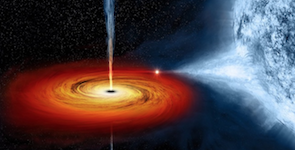Accreting binary populations in Nearby Galaxies: Observations and Simulations (A-BINGOS)

Accreting binaries are binary stellar systems consisting of a compact object that accretes material from a donor star. The compact object can be either a white dwarf, a neutron star, or a black hole, while the donor star can be either a massive star (High-mass X-ray binaries), or a low mass star (Low-mass X-ray binaries). Since accreting binaries are the end-points of stellar evolution are key for understanding the final stages of stellar evolution, and our main tool for studying the populations of black-holes and neutron stars. In addition very energetic phenomena such as mergers between compact objects resulting in gravitational wave sources or short gamma-ray bursts are the endpoints of the evolution of accreting binaries.
The goal of this ERC project of Prof. Andreas Zezas, to study the formation and evolution mechanisms that produce the different types of accreting binaries observed in nearby galaxies. We can achieve this by correlating the accreting binary populations in nearby galaxies with their recent and past star-forming activity, and comparing these results with models for the formation and evolution of accreting binaries.
The main achievements of this program so far are:
- The development of a new approach in X-ray binary population synthesis (Andrews et al. 2018)
- The direct measurement of the formation efficiency of young accreting binaries as a function of the age of their parent stellar populations (e.g. Antoniou et al. 2019)
- Study of the kick velocities and travel distances of double neutron-star systems (Andrews et al. 2019)
- Systematic studies of recent and past star-forming activity in sub-galactic (1 kpc2) scales (Maragkoudakis et al. 2017)
- Systematic studies of the variations of X-ray binary populations in subgalactic scales (Anastasopoulou et al. 2016, 2019)
- Development of diagnostics for the classification of the compact objects in accreting binaries
- Measurement of black-hole and neutron-star demographics in nearby galaxies (e.g. Vulic et al. 2018)
